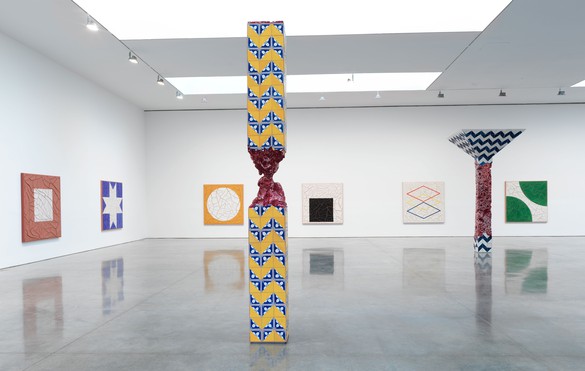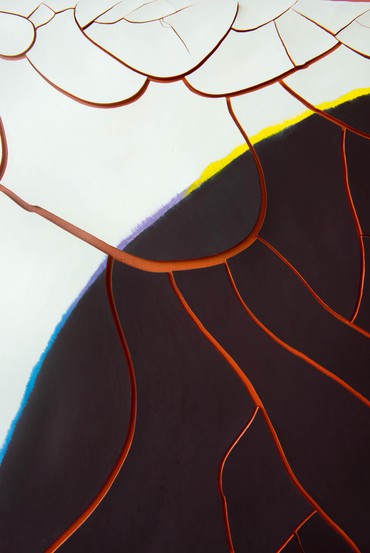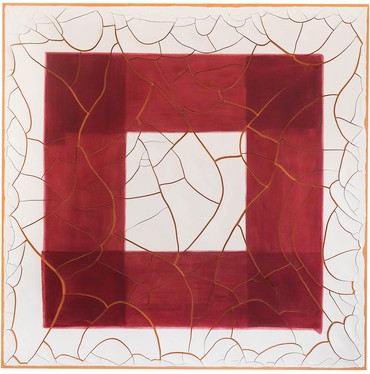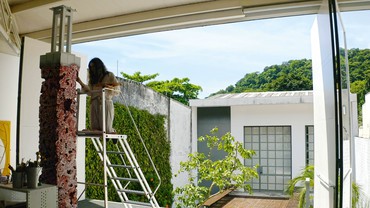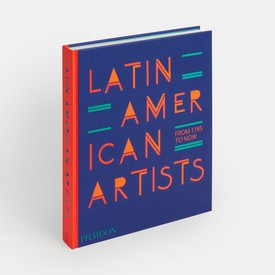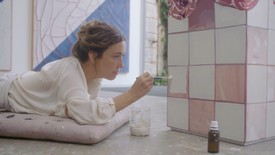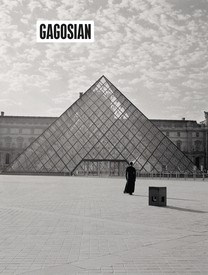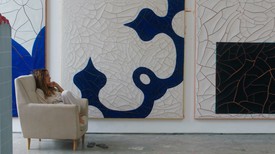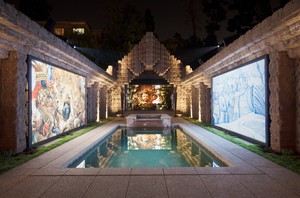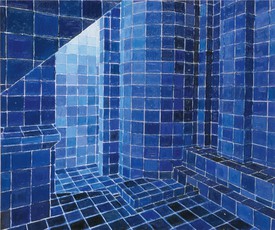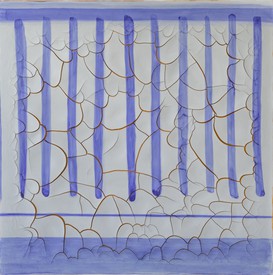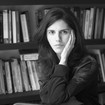
Luisa Duarte is an art critic and independent curator based in São Paulo. She has an MA in philosophy from the Pontifical Catholic University and a PhD from the UERJ Art Institute. Duarte was general coordinator of the conference cycle “The Bienal of São Paulo and the Brazilian Artistic Environment: Memory and Projection,” a debate platform of the 28th São Paulo Bienal, Em Vivo contato . . .(2008).
Our era has been marked by a regressive desire for segregation. The reactionary movements that darken the world today share an appeal to ideas of community, of unity in sameness, and of the rejection of difference, clinging to an imagined community of resemblance guided by notions of caste, purity, and exclusion.1 An entire iconography of walls, metal barriers, and closed borders has emerged, drawing a thick line between “us” and “them.”
Adriana Varejão’s art, as a poetic and political event, lies in stark opposition to this trend. Since the 1990s, before anticolonialist studies and practices became central to debates on contemporary art, Varejão’s practice has been informed by a critical vision of colonialism, one equipped with an ethos at once baroque and anthropophagic. One of the tenets of the Brazilian Antropofagia movement, whose manifesto was published in 1928, is “I am only interested in what isn’t mine.”2
A central element of Varejão’s poetics of difference—a poetics motivated by the desire to see what can happen in the encounter with the other—is the azulejo.3 Arab in origin, the azulejo is a ceramic tile that played an important role in Portuguese architecture and came to Brazil during the colonial period. Having absorbed various influences—from Moorish artisanal work to Italian Renaissance painting, from Chinese porcelain to the Latin American Baroque—the azulejo encapsulates a multitude of cultural encounters. It is precisely this locus of contagion between different latitudes and periods that makes it central to Varejão’s art and the guiding principle of her exhibition Talavera, at Gagosian, New York, in the spring of 2021.
The exhibition gathers large-scale paintings inspired by azulejos found in the city of Puebla, Mexico. Varejão’s specific starting point is a photograph of azulejos that she took in the mid-1990s, when she was dividing her time between Rio de Janeiro, her hometown, and Mexico. In each of these paintings, it is as if she were using a magnifying glass on the small azulejos of a Talavera wall, and, in a gesture combining attention and curiosity, drifting and observing, were capturing a variety of things that our eye, quickly scanning the surface, would have trouble noticing: curving black forms; blue flourishes; a yellow square; another square, this one in translucent reds; three diamonds, a red and a blue one overlaying one in yellow; a large black sphere with a light blue showing through within its borders; a white sphere with an orange surround; a subtle blue frame outlining a huge square target; a target in which a diagonal forms two triangles, one white, one blue; and a decentralized black square on a white ground. For Varejão, it is never a question of copying an azulejo, never mind of merely reproducing one. It is a question, rather, of parodying and theatricalizing the genre. All those largely geometrical motifs are painted not on a serene backdrop but on one traversed by tremors: Varejão makes incisions and gashes in the picture plane, revealing its interior and giving the canvas a kind of corporeality. In doing so, little by little, it acquires a crackled effect, the painting developing a series of fissures across its surface. Inspired by eleventh-century Song-dynasty ceramics, whose monochrome enamels are characterized by controlled cracks, Varejão has used craquelure from the beginning of her career. It emerges in her work as a kind of wound, alluding to the effect of time on materials and revealing a rhizomatic structure. Because the final form of craquelure is impossible to predict, it combines both calculation and chance.
These paintings traversed by tremors echo what the Martinican philosopher and critic Édouard Glissant called a “poetics of diversity.”4 First, they mark Varejão’s encounter with a Talavera wall in Puebla, the capital of the Mexican Baroque. Talavera is a kind of applied art, popular and hybrid, with roots in both Hispanic and indigenous practices. Second, through the visual excess typical of Varejão’s work, they capture the presence, generally unsuspected in Talavera, of supposedly clean, neutral, abstract geometric forms. The artist creates a kind of filter that reveals the microuniverses within the myriad forms of Talavera. But the goal of this filter is not to purify, to separate, but to combine—a crossbreeding, or, better, to borrow again from Glissant, a creolization: the creolization that comes from painting not on a clean white stretched canvas but on the convulsive, tremulous surface of polysemic craquelure. In other words, different cultures and latitudes interweave, from Portugal to China, from Mexico to Brazil, different points that touch to create a universe never seen before. I use the word “touch” to emphasize the tactile, corporeal, eroticized sign in Varejão’s baroque art.
Varejão’s work has since the beginning had ties to the Baroque tradition, and creolization, in Glissant’s words, is “always a manifestation of the baroque.”5 Far removed from notions of caste, purity, and single identity, the baroque is close instead to the relational proliferation of intersections and the embodiment of difference. If the European Baroque is linked to the Counter-Reformation, Varejão affiliates herself with a Baroque style proper to the Americas, described by the Cuban writer José Lezama Lima as the art of counterconquest. By capturing the geometric forms hidden with a popular medium of the Mexican Baroque, and by laying such forms on a craquelure base, Varejão might seem to remind us that geometric abstraction is not the exclusive province of white Western thought. This shift in perspective is aligned with an idea at the heart of Varejão’s poetics, the idea of counterconquest. It is not just a question of juxtaposing geometry—ideal, limpid, organized—with unpredictable rhizomatic traces close to the vital realm of the body; it is also a question of speculating about another origin—and, why not?, another destiny—for geometric abstraction. From the graphics of pre-Columbian art6 to Talavera, from indigenous body painting to Brazilian Neo-Concretism,7 from Athos Bulcão’s azulejos in Brasília8 to the straight lines of Rubem Valentim’s sacred motifs, there are many roots and destinations for a sensitive geometry.9 In the end, Varejão suggests, with this displacement, this exercise in profanation,10 the possibility emerges of other epistemologies, distinct from those governed by anthro/phallo/egocentric and totalizing discourses. In this sense we descry an anticolonial poetics that underscores the importance of creating epistemologies born of a baroque process, one that always conjures the embodiment of difference.
But let’s be clear: such a profanation of reference points, such a subversion of official histories in favor of marginal ones, such an affirmation of epistemologies distinct from those of the colonist, doesn’t happen quietly.11 As Frantz Fanon reminds us, “Decolonization is always a violent phenomenon” because it is a “program of complete disorder. But it cannot come as a result of magical practices, nor of a natural shock, nor of a friendly understanding.”12 It is in this sense that the three painted sculptures Ruínas de Charque (Meat Ruins, 2021), which conclude the exhibition, reveal a more dramatic side of Varejão’s explorations.
The Ruínas simulate architectural fragments covered in paintings of azulejos that reference Talavera. Inside, however, in sharp contrast to the planar geometrical surface of the cold modernist grid, we find a warm representation of the body’s interior. In a substitution for anodyne gray cement, Varejão reveals a theatricalized version of charque de carne, or beef jerky—the sun-dried salted meat, slow to spoil, that was a staple of the slaves who worked the sugarcane fields of northeastern Brazil in the sixteenth century.
The Cuban writer and poet Severo Sarduy identified substitution as a signal process of the Baroque. Depending on what elements it puts in play, this substitution isn’t simply a neutral permutation; it displaces the original meaning to establish a new one. If ruins evoke a time that never came to an end—something so familiar in Brazil, a country in which “everything appears to be under construction and is already a ruin”13 —Varejão presents this era as permeated by a history of violence and eroticism.14
Though in her paintings Varejão works from traces and remnants of Talavera, these ruins remain traces and remnants of a time that is past, but whose echoes darken the present and clamor for collective reckoning.15 Varejão goes against the grain of the past in order to bring to light marginal histories and to reveal the perspective of the vanquished. To do so, she deploys a gesture of baroque counterpoint, tracing a cartography woven of different cultures, eras, and latitudes, marked by the political tension of her own poetics of difference.
We can, at last, return to the beginning of this essay, where we referred to a present marked by a regressive desire for segregation, for the unity of like and like. It seems clear that like Varejão’s work itself, her exhibition is an event, at once poetic and political, that lies at the opposite pole from this regressive shift. Her work seems to say that a possible way of overturning such political currents lies not in affirming pure identities but in the often imponderable experience of the encounter, in the mixture of the many, the different. To once more evoke Glissant, “The single root is that which kills everything around it whereas the rhizome is the root that reaches out to meet other roots.”16 In other words, each of Varejão’s rhizomatic craquelures is a call to meet other voices, other cultures, other climes, offering imaginative pathways to a more polyphonic yet more unified world.
1It is important to remember that the world that is moving quickly in a counterrevolutionary direction is simultaneously seeing a once-imperceptible shift of tectonic plates in terms of traditional notions of race, gender, and family and of a Eurocentric canon. In other words, these regressive currents are a response to an ongoing process of anticolonial historical revisionism that is creating a new geography and proposing new epistemologies.
2Oswald Andrade, “Manifesto Antropófago” (Cannibalist manifesto), Revista de Antropofagia, São Paulo, 1928.
3On the question of the other in contemporary art, see Bonaventure Soh Bejeng Ndikung, “Disothering as method (Leh zo, a me ke nde za),” in Solange Farkas, Gabriel Bogossian, Luisa Duarte, and Miguel A. López, 21a Bienal de arte contemporãnea Sesc:VídeoBrasil—Comunidades imaginadas, exh. cat. (São Paulo: Editora Sesc, 2019), pp. 68–71.
4Édouard Glissant, Introduction to a Poetics of Diversity, trans. Celia Britton (Liverpool: Liverpool University Press, 2020).
5Ibid., p. 30.
6Readers should remember here the relationship between Anni and Josef Albers and Latin America, a connection forged during their travels in Mexico, Peru, Chile, and Cuba between 1934 and 1967. Through this contact with Latin American culture, the German artists were influenced by the geometries of pre-Columbian art and indigenous graphics.
7The Neo-Concrete movement developed a geometric abstraction that referenced the body, nature, politics, the street, and the everyday. It began in Rio de Janeiro in 1959 in response to the Concrete movement, and included such artists as Lygia Clark, Hélio Oiticica, and Lygia Pape.
8Athos Bulcão was a foundational artist in what we think of as Brazilian modernism, having been an important collaborator with the architect Oscar Niemeyer. Well-known for his azulejo works in the Brazilian capital, he is less recognized for the democracy of his practice, which involved construction workers in the creative process. His singular patterns thus function as open systems, reflecting multiple decision-makers.
9See Roberto Pontual, América Latina, geometria sensível, exh. cat. Museo de Arte Moderna (Rio de Janeiro: Ediçoes Jornal do Brasil, 1978), and Rosana Paulino and Renata Felinto, “Violenta geometria,” Revista Zum, no. 19 (December 2020).
10An entire essay could be written on Adriana Varejão’s work taking Giorgio Agamben’s notion of profanation as a point of departure. See Agamben, Profanations (New York: Zone Books, 2007).
11See Adriano Pedrosa, Adriana Varejão. Histórias às margens, exh. cat. (São Paulo: Museu de Arte Moderna, 2012).
12Frantz Fanon, The Wretched of the Earth (New York: Grove Weidenfeld, 1963), pp. 33, 35.
13Caetano Veloso, “Fora da Ordem,” from the album Circuladô, 1991. Veloso was thinking about the sense of temporality in New World cities expressed by the anthropologist Claude Lévi-Strauss in his book Tristes Tropiques (1955). More specifically, Veloso had in mind this passage: “Some mischievous spirit has defined America as a country which has moved from barbarism to decadence without enjoying any intermediary phase of civilization. The formula could more correctly be applied to the towns of the New World, which pass from freshness to decay without ever being simply old.” Lévi-Strauss, Tristes Tropiques, Eng. trans. John Weightman and Doreen Weightman, 1973 (reprint ed. Penguin Books, 2012), p. 118.
14Severo Sarduy reflected on the relationship between Baroque language and eroticism in his book Escrito sobre um corpo. The Baroque has the very qualities of excess and expenditure, each its own justification, that characterize eroticism. In the Baroque, language deviates from its natural purpose, communication, just as in eroticism, sex deviates from its purpose of reproduction. Sarduy writes, “This obsessive repetition of a useless thing (as it no longer has access to the ideal of work) is what determines the Baroque as play, as opposed to the classical work that is designated as work. The inevitable exclamation that all Baroque acts elicit, whether in painting or confection—‘What work!’—masks a poorly disguised adjective: What lost work. What a waste, what effort for no purpose. Here the superego of Homo faber, who exists for work, declares itself as against delight, the voluptuousness of gold, happiness, unfolding, pleasure. Play, loss, waste, and pleasure: that is, eroticism as an activity that is always ludic, never more than a parody of the function of reproduction, a transgression of the utilitarian, of the dialogue of our ‘natural’ bodies.” Sarduy, Escrito sobre um corpo (São Paulo: Perspectiva, 1979), p. 77. Translated from the Portuguese by Sheila Faria Glaser.
15Glissant uses the term “traces” to talk about the condition of African migrants who arrive despoiled of everything, of every possibility, even of their language. Given this condition, the migrant, according to Glissant, “reconstructs, on the basis of traces, a language and forms of art that one could say are valid for everyone. . . . Trace thought seems to me to be a new dimension that in the current state of the world we must set in opposition to what I call ‘systematic thought’ or systems of thought.” Introduction to a Poetics of Diversity, p. 7.
16Ibid., p. 37. On the difference between a single root and a rhizome, Glissant writes, “Because in fact that is what is at stake here: a sublime and deadly idea that the peoples of Europe and Western cultures have exported around the world, i.e. that every identity is a root-identity exclusive of all others. This view of identity is opposed to the idea, ‘real’ today in composite cultures, of identity as factor and result of a creolization: that is, of identity as rhizome, identity no longer a single root, but a root reaching out to other roots.” Ibid., p. 11.
Translated from the Portuguese by Sheila Faria Glaser
Artwork © Adriana Varejão
Photos: Vincente de Mello
